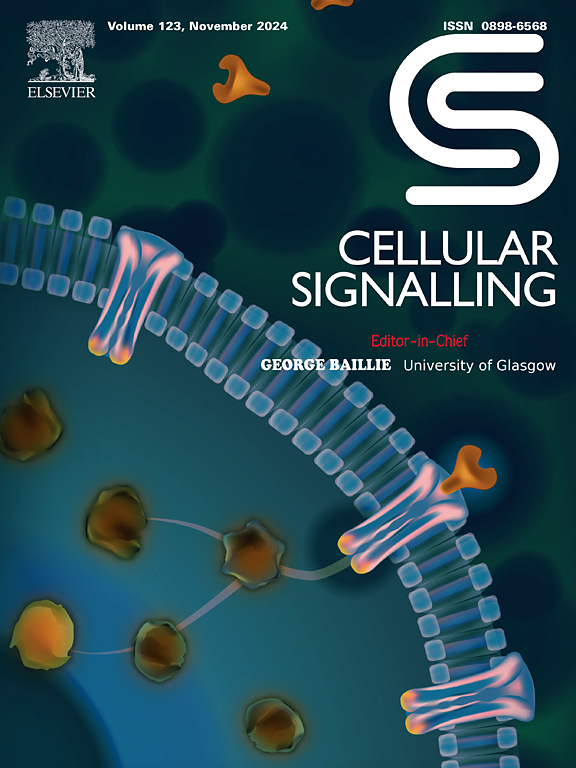铁下垂通过靶向LHX1和IRE-1导致早产儿内质网应激。
IF 4.4
2区 生物学
Q2 CELL BIOLOGY
引用次数: 0
摘要
早产(PTB)显著促进新生儿死亡率,强调需要详细了解其发病机制。本研究旨在探讨铁依赖性细胞死亡过程铁凋亡在肺结核中的作用,并探讨其与内质网应激(ERS)之间可能存在的串扰。首先,我们探讨了PTB产妇胎盘样本中铁下垂的发生。然后,我们通过缺氧/再氧化(H/R)培养滋养细胞建立了铁下垂细胞模型,发现H/R暴露的细胞可以诱导ERS,并通过fe -1抑制铁下垂而减弱ERS,表明铁下垂可以诱导ERS。同时,我们还通过tunicamycin (TM)处理滋养细胞诱导ERS。fer1抑制铁下垂可减轻tm诱导的内质网应激。TM降低了滋养细胞的活力和迁移,同时促进了细胞凋亡和自噬,而抑制铁下垂则逆转了这一作用。因此,靶向铁下垂可能有助于减轻内质网应激相关的PTB病理生理变化。机械上,我们发现两种内质网介质LIM同源盒1 (LHX1)/肌醇要求酶1 (IRE-1)在H/R处理的细胞中也上调。沉默LHX1或IRE-1被证明可以逆转H/ r诱导的铁下垂。此外,救援实验进一步揭示LHX1通过调节IRE-1促进铁下垂。综上所述,铁下垂导致ERS,并在PTB中起关键作用,强调LHX1/IRE-1轴是减轻铁下垂相关并发症的有希望的治疗靶点。这些发现为早产儿的创新干预提供了基础。本文章由计算机程序翻译,如有差异,请以英文原文为准。
Ferroptosis contributed to endoplasmic reticulum stress in preterm birth by targeting LHX1 and IRE-1
Preterm birth (PTB) significantly contributed to neonatal mortality, emphasizing the need for a detailed understanding of its pathogenesis. This study aimed to explore the involvement of ferroptosis, an iron-dependent cell death process, in PTB and investigated the possible crosstalk with endoplasmic reticulum stress (ERS). First, we explored the occurrence of ferroptosis in placenta samples from PTB parturients. Then we established a ferroptosis cell model was established by subjecting trophoblast cells to hypoxia/reoxygenation (H/R), and found the ERS was induced in H/R exposed cells and was attenuated by ferroptosis inhibition using Fer-1, suggesting that ferroptosis could induce ERS. Meanwhile, we also induced ERS in trophoblast cells via tunicamycin (TM) treatment. Ferroptosis inhibition with Fer-1 alleviated TM-induced ER stress. TM treatment reduced trophoblast cell viability and migration while promoted apoptosis and autophagy, effects that were reversed by ferroptosis inhibition. Thus, targeting ferroptosis might help mitigate ER stress-related pathophysiological changes in PTB. Mechanically, we found two ERS mediators LIM homeobox 1 (LHX1)/Inositol-requiring enzyme 1 (IRE-1) were also upregulated in H/R treated cells. Silencing LHX1 or IRE-1 was demonstrated to reverse the H/R-induced ferroptosis. Additionally, rescue assays further revealed that LHX1 promoted ferroptosis by regulating IRE-1. In conclusion, ferroptosis contributed to ERS and was critically involved in PTB, highlighting the LHX1/IRE-1 axis as a promising therapeutic target for mitigating ferroptosis-related complications. These findings offered a foundation for innovative interventions in preterm birth.
求助全文
通过发布文献求助,成功后即可免费获取论文全文。
去求助
来源期刊

Cellular signalling
生物-细胞生物学
CiteScore
8.40
自引率
0.00%
发文量
250
审稿时长
27 days
期刊介绍:
Cellular Signalling publishes original research describing fundamental and clinical findings on the mechanisms, actions and structural components of cellular signalling systems in vitro and in vivo.
Cellular Signalling aims at full length research papers defining signalling systems ranging from microorganisms to cells, tissues and higher organisms.
 求助内容:
求助内容: 应助结果提醒方式:
应助结果提醒方式:


